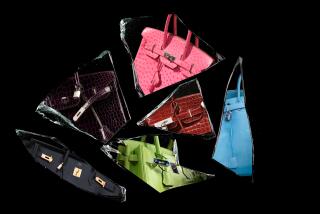Ryder Found Guilty in Shoplifting Case
- Share via
Film star Winona Ryder was convicted Wednesday of felony grand theft and vandalism for shoplifting more than $5,500 in designer merchandise from Saks Fifth Avenue in Beverly Hills.
The Oscar-nominated actress, who was acquitted of a burglary charge, sat motionless as she watched the Superior Court clerk read the verdicts. Ryder refused to discuss the case before leaving the courthouse, saying only, “I’m sorry. Thanks for asking. I just can’t talk right now.”
Though Ryder faces a possible three-year prison term, prosecutors said they do not plan to demand jail time at her sentencing hearing Dec. 6. Deputy Dist. Atty. Ann Rundle said she will ask the judge to place Ryder, who has no prior criminal record, on probation. Rundle will also ask that Ryder pay restitution to the department store and undertake community service.
“We were simply asking for Ms. Ryder to take responsibility for her conduct, and that’s what this trial has been about,” Rundle said to a herd of reporters and photographers outside the Beverly Hills courthouse.
Ryder purchased $3,700 worth of merchandise with a credit card before leaving Saks with an additional 20 items that she did not pay for. Much of the prosecution’s case centered around a lengthy videotape that showed Ryder, the star of such films as “The Age of Innocence” and “Girl, Interrupted,” walking through the store laden with shopping bags.
Ryder’s attorney, Mark Geragos, who sped off in his sports car with his client after the verdict, said later, “I’m disappointed and plan to file a motion for new trial.” He said he would not comment further until after the sentencing hearing. Geragos argued during the trial that his client was a victim of overzealous security guards who planted evidence and lied to ensure a conviction.
Judge Elden S. Fox allowed Ryder, 31, to remain free on $20,000 bail until sentencing, declaring that she is not a flight risk.
The six men and six women of the jury deliberated for five hours on Tuesday and another 30 minutes Wednesday before signaling the judge that they had reached a decision. The verdicts were read at 11:40 a.m. in the packed courtroom. The jurors, who included Hollywood producer Peter Guber, did not look at Ryder as they walked in. Afterward, they declined to speak to reporters and were escorted to their cars by sheriff’s deputies.
“I have fulfilled my obligation to the court as a private citizen and will have no further comment on the matter,” said Guber in a statement issued Wednesday afternoon.
Juror With Connections
Guber’s selection as a juror raised questions among attorneys and producers because he headed Sony Pictures while the studio was producing three of Ryder’s films. Several other jurors also had ties to the entertainment industry.
Alternate juror Sherman Pore said Wednesday afternoon that he was surprised by the verdicts and wishes that he had been in the deliberation room. The defense raised many questions that were not answered by the prosecution, he said.
Pore said he wondered, for example, why police did not fingerprint sensor tags that matched merchandise found on Ryder and why the security manager put two other tags found in Ryder’s dressing room back into circulation at the store. Pore also said he believed that a key prosecution witness, Saks security guard Colleen Rainey, showed through her demeanor that she was bent on prosecuting rather than testifying.
“Do I think she is guilty? Probably,” said Pore, a retired mechanical maintenance engineer. “But do I think they proved it beyond a reasonable doubt? I don’t think so.”
Dist. Atty. Steve Cooley issued a brief statement Wednesday afternoon saying that he hoped the sentence would address the defendant’s problems that may have led her to commit the crimes.
“The jury trial verdicts indicate that in Los Angeles County justice is blind regardless of the status of the accused,” Cooley’s statement read.
Saks attorney Kenneth Metzner, who was accused by Geragos of conspiring with security guards to fabricate evidence, thanked the jury, the district attorney’s office and the Beverly Hills Police Department.
“From the beginning of the events which gave rise to this case, through trial, Saks Fifth Avenue has remained committed to doing the right thing,” he said in a prepared statement outside court. “Saks is proud of the professionalism and integrity displayed by its asset protection staff and sales associates involved in this matter.”
Rundle, who called six witnesses, argued that Ryder shoplifted the merchandise for the thrill of it and had her own “5 for 1” bonus program, stealing five items for every one she purchased.
Saks security manager Kenneth Evans, who came to the courthouse Wednesday to hear the verdict, testified that he followed Ryder on store surveillance cameras, watching her stuff socks and hair bows into a hat and select items off racks without checking their prices.
Security guard Rainey told jurors that she peeked through slats in Ryder’s dressing room door and saw her snip sensor tags off two purses, cutting holes in blouses and injuring her own finger in the process. Ryder then left the store without paying for items including a $760 Marc Jacobs thermal top and a $540 Natori handbag, Rainey told jurors.
Both Evans and Rainey testified that Ryder told them she took the clothes and accessories as research for a film role. Rainey also testified that Ryder said, “Didn’t my assistant pay for it?” The security tapes showed no assistant with Ryder.
Prosecutors were not permitted by Judge Fox to show jurors statements Ryder signed for Saks employees that she had stolen the merchandise.
Rundle said the burglary charge required prosecutors to prove that Ryder had the intent to steal when she entered the department store on Dec. 12 last year. Rundle argued to jurors that Ryder came equipped with scissors to cut off sensor tags and a garment bag to conceal merchandise, but the prosecutor conceded Wednesday, “We knew that this would be a difficult decision for the jury because we did not have evidence of when she specifically entered the store.”
Saks guards said they did not begin to follow Ryder on surveillance cameras until after she had purchased a pair of shoes at the store.
In Ryder’s Defense
Geragos, who called four witnesses, argued that there was no theft and that his client was simply shopping that day as she frequently did at the posh department store. Geragos suggested that Rainey profited from the case and that Evans just wanted to appease his corporate bosses.
The main defense witness was Michael Shoar, a former Saks employee who testified that Evans told him shortly after Ryder’s arrest that he planned to make up evidence to prove the charges. Rundle, during cross-examination, depicted Shoar as a disgruntled former employee, getting him to admit that he was suing Saks and held a recent protest in front of the Beverly Hills store.
The defense also called a Beverly Hills police officer and the spokeswoman from the district attorney’s office, who testified that they mistakenly told reporters that Ryder was seen on videotape snipping tags. Geragos insists that Saks employees changed their stories after prosecutors realized that the tape did not show what they thought.
While the trial concerned relatively minor charges, it drew reporters from as far as England and Italy, who packed the courthouse each day and lined up outside to photograph the film star as she walked in with an entourage.
Ryder, who showed up in stylish suits or dresses each day, took notes as she listened to testimony. As some prosecution witnesses testified, she sighed and shook her head, turning back to her family with looks of disbelief. But at breaks, she chatted courteously with the prosecutor.
After the verdicts were read, Ryder, wearing a plum-colored dress, looked back at her family and friends and gave a quick, almost sad, smile.
“Winona is grateful to her family, friends and those who have supported her,” Ryder’s publicist, Mara Buxbaum said later. “She was preparing for the worst and hoping for the best.”
Rundle said later that she believed Ryder was a nice person. “This was never about her character, only her conduct,” she said.
The case went to trial after neither side would budge during plea negotiations -- prosecutors insisting that Ryder plead to a felony charge and defense attorneys holding out for a misdemeanor.
Nevertheless, the trial had some light moments, including Rundle’s Top 10 list during her closing argument about what the law on shoplifting does not say. Among the items: Only poor people steal, and Saks deserves to get ripped off because it sells $200 hair bows. Geragos mocked testimony that Ryder damaged merchandise by snipping off sensor tags, asking jurors whether they believed his client planned to start a line of “Winona Wear” with holes in the blouses.
During the trial, a state Court of Appeal ruled twice that Judge Fox had erred in holding closed hearings and withholding transcripts and jury questionnaires from the public. The rulings came in response to legal motions from several media organizations.
At the appellate court’s direction, Fox released the questionnaires Wednesday. All but two of the jurors and alternates had read news articles or seen TV reports about Ryder before the trial began, according to the questionnaires. “I am fairly familiar with the charges and have heard that a drug aspect of the case was dropped early on,” one wrote.
Only one expressed any feelings of sympathy toward Ryder before the trial began. “I believe she has been vilified in the press to some extent,” the questionnaire read.
Although the names of the jurors had been removed from the jury questionnaires before they were distributed to the public, one appeared to be Guber’s form. “I am in the entertainment business, former chairman and CEO of various major companies,” it read. But he added that there was no doubt whether he could be fair and objective in the case.
*
Times staff writers Anita M. Busch and Daniel Hernandez contributed to this report.
More to Read
Sign up for Essential California
The most important California stories and recommendations in your inbox every morning.
You may occasionally receive promotional content from the Los Angeles Times.










